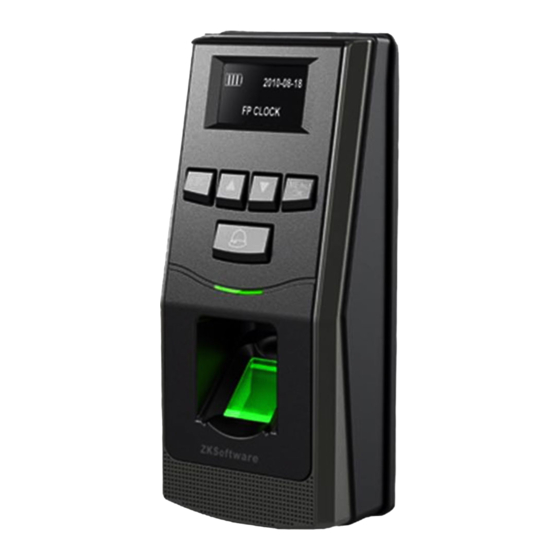
Table of Contents
Advertisement
Quick Links
F6 Installation Guide
1. Equipment Installation
Fixing Hole
F6 Mounting Paper
(only for your reference)
Wiring Hole
Instruction for the Mounting Paper
Before the device is fastened, please
stick the paper to the place where you
want to install it, then make holes and
lay cables according to the mounting
paper.
10
Fixing Hole
11
(1) Post the mounting template on the
(2) Remove the screws on the (3) Take away the back plate
wall, drill the holes according to
the marks on the template (holes
for screws and wiring).
(4) Fix the plastic pad and the back
(5) Tighten the screws on the bottom,
plate on the wall according to
the mounting paper.
2. Structure and Function
RS485
⑥
RS485 Converter
④
①
⑤
②
Lock
Exit Button
Sensor
Door Bell
③
Alarm
Version: V1.2 Date: March, 2012
bottom of the device.
fix the device to the back plate.
Access Control System Function
(1) If a registered user verified, the device will export
the signal to unlock the door.
EXIT
(2) Door sensor will detect the on-off state. If the door is
BUTTON
unexpected opened or improperly closed, the alarm
signal (digital value) will be triggered.
(3) If the device is removed illegally, it will output an
alarm signal.
(4) External exit button is supported, it is convenient to
open the door inside.
(5) External door bell is supported.
(6) Supports RS485 mode to connect with PC. One PC
can manage multiple devices.
3.Lock Connection
(1) Share power with the lock:
+
+12V
-
GND
BELL-
DC12V
BELL+
DC12V
SEN
GND
BUT
-
NO1
COM1
FR 107
+
NC1
NO LOCK
NO2
NC LOCK
COM2
(2) Does not share power with the lock:
+
+12V
GND
-
DC12V
DC12V
BELL-
BELL+
+
SEN
GND
-
NO LOCK
BUT
DC Power
NO1
COM1
+
NC1
FR 107
NO2
COM2
DC Power
NC LOCK
Notes:
(1) The system supports NO LOCK and NC LOCK. For example the NO LOCK (normally open at
power on) is connected with '
NO' and COM terminals, and the NC LOCK(normally close at power on )
'
is connected with 'NC' and 'COM' terminals.
(2) When the Electrical Lock is connected to the Access Control System, you need to parallel one FR107
diode (equipped in the package) to prevent the self-inductance EMF affecting the system, do not
reverse the polarities.
①:
'I': Device output current, '
U
': Lock voltage,
LOCK
4. Other Parts Connection:
BELL-
BELL+
Door Bell
SEN
GND
BUT
EXIT
BUTTON
Exit Button
NO1
COM1
NC1
Alarm Power
Door Sensor
NO2
Alarm
-
COM2
+
Alarm Voltage output ≤ DC 12V
+
+12V
GND
-
BELL-
Device shares power with the lock:
BELL+
SEN
U
=12V, I-I
LOCK
LOCK
-
GND
BUT
The distance between the lock
FR 107
NO1
+
and the device
shares Ilock 1A
COM1
NC1
is equal or less than10 meters.
NO2
COM2
+
+12V
-
GND
Does not shares power with the lock:
-
BELL-
BELL+
FR 107
A.
U
=12V I-
I
SEN
LOCK
LOCK
+
GND
≠12V;
B
. U
LOCK
BUT
-
C. The distance between the lock and
NO1
COM1
the device is more than 10 meters.
+
NC1
NO2
COM2
'
'
I
': Lock current.
LOCK
5. Power Connection:
Input DC 12V, 500mA (50mA standby). Positive
is connected with '+12V', negative is connected
with 'GND' (do not reverse the polarities).
+
+12V
-
GND
DC12V
>1A...①
≤1A;
Advertisement
Table of Contents

Subscribe to Our Youtube Channel
Summary of Contents for ZKTeco F6
- Page 1 3.Lock Connection F6 Installation Guide (1) Share power with the lock: Version: V1.2 Date: March, 2012 +12V +12V 1. Equipment Installation BELL- BELL- Device shares power with the lock: DC12V BELL+ DC12V BELL+ =12V, I-I >1A…① Fixing Hole LOCK LOCK...
- Page 2 6. Wiegand Output ! Warning: No operating with power on! The device supports standard Wiegand 26 / Wiegand 34 output, so you can connect it with most of 8. Communication the access control devices by now. DATA0 DATA1 This device could use RS485 mode to communicate and exchange information with PC software About the terminals definition, please refer to the following table: and supports remote control.












Need help?
Do you have a question about the F6 and is the answer not in the manual?
Questions and answers